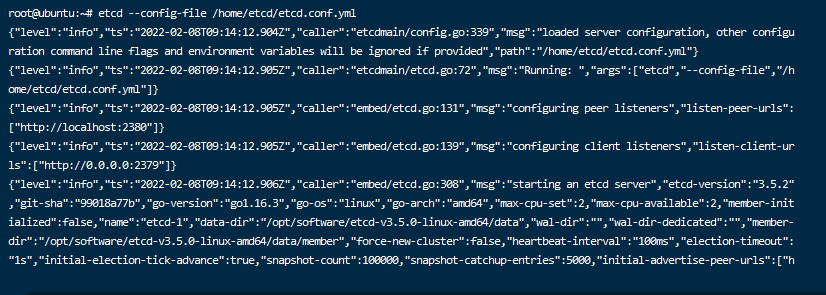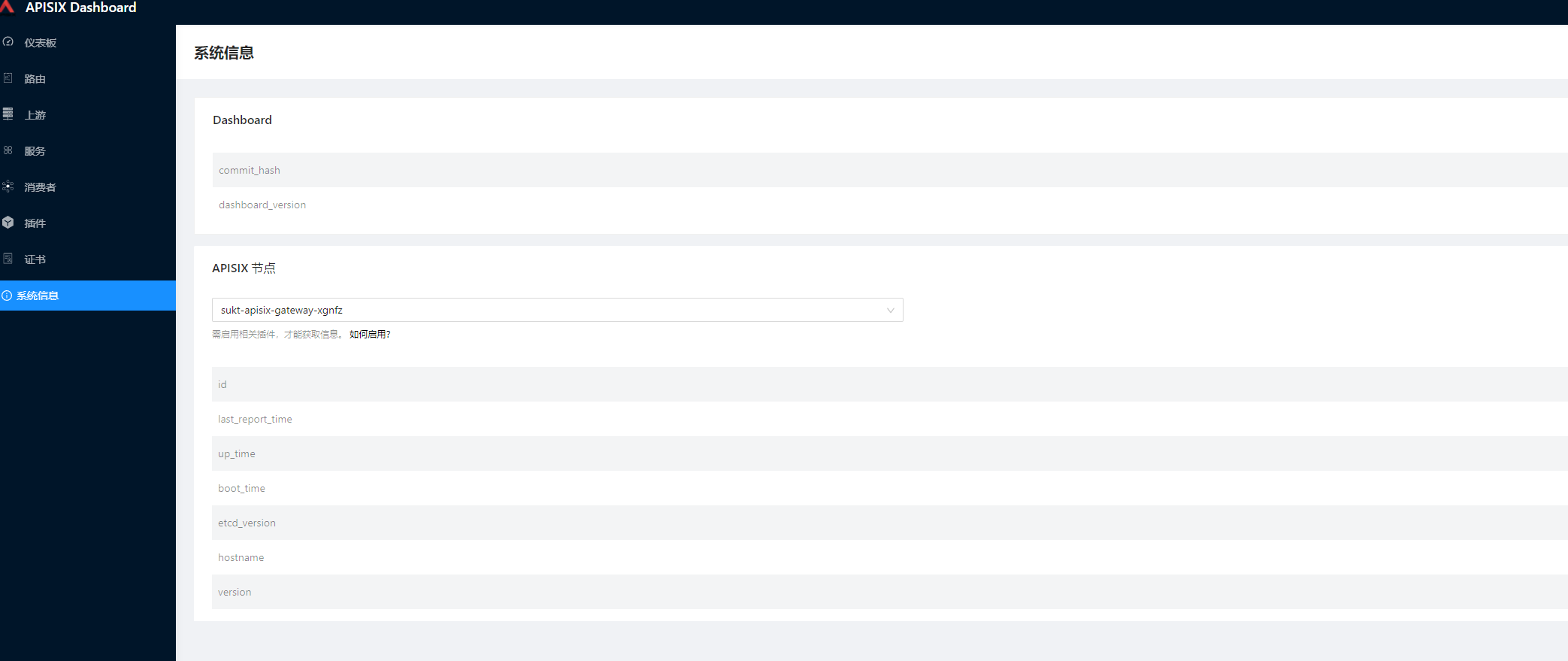K8S中部署apisix(非ingress)
不使用pvc的方式在K8S中部署apisix-gateway
简介
因为公司项目准备重构,现在做技术储备,之前公司项目使用的ocelot做网关,ocelot是.net平台下的一个网关,也是很不错,但是在选型的时候需要考虑到性能问题,所以在这次重构中抛弃了ocelot,看了apisix和kong,kong也是一个很不错的网关,不过因为对kong不太了解,刚好有朋友在用apisix所以就选了apisix来做新的网关,避免了重复掉到坑里面。不单单是部署,后面还要使用apisix进行身份认证等一系列的插件都会使用,所以慢慢更新吧。
- 我的apisix使用etcd作为数据存储服务器,官方的使用pvc方式或者docker-compose的方式,对于新手不太友好,本篇是从etcd的安装到apisix的打通都会涉及。
- apisix是服务端,用来进行网络请求转发。
- apisix-dashboard是他的控制面板,用来进行可视化配置。
apisix介绍
apisix是基于 OpenResty + etcd 实现的云原生、高性能、可扩展的微服务 API 网关。它是国人开源,目前已经进入 Apache 进行孵化。APISIX 通过插件机制,提供了动态负载平衡、身份验证、限流限速等等功能,当然我们也可以自己开发插件进行拓展。
- 动态负载均衡:跨多个上游服务的动态负载均衡,目前已支持 round-robin 轮询和一致性哈希算法。
- 身份验证:支持 key-auth、JWT、basic-auth、wolf-rbac 等多种认证方式。
- 限流限速:可以基于速率、请求数、并发等维度限制。
1、部署etcd
etcd 是一个分布式键值对存储,设计用来可靠而快速的保存关键数据并提供访问。通过分布式锁,leader选举和写屏障(write barriers)来实现可靠的分布式协作。etcd集群是为高可用,持久性数据存储和检索而准备。
ubuntu部署etcd
ubuntu中部署etcd的两种方式:
一种是去GitHub下载二进制的安装包,还有一种是apt-get install etcd,第二种方式我也尝试过,可能是我软件源的问题,版本有点老,所以我就换成了使用第一种方式,而且也比较推荐使用第一种方式。
我用的etcd下载的版本是3.5.2,废话不多说直接看步骤:
1.1、将etcd etcdctl etcdutl 二进制文件拷贝到/usr/local/bin目录下
/usr/local/bin
1.2、创建一个etcd的etcd.conf.yml,将下面代码拷贝进去,我这里etcd就简单的配置了一下,没有做集群,所以yml很简单。
name: etcd-1data-dir: /home/etcd/datalisten-client-urls: http://0.0.0.0:2379advertise-client-urls: http://0.0.0.0:2379
1.3、通过etcd --config-file etcd.conf.yml的路径运行,如下图就是成功了,也可以使用etcd manager客户端来测试。


1.4、如果使用etcd直接启动的话没有办法后台运行,所以我们需要在/etc/systemd/system目录下创建一个etcd.service来进行后台运行。
[Unit]Description=ETCD ServerDocumentation=https://github.com/coreos/etcdAfter=network-online.targetWants=network-online.target[Service]User=rootGroup=rootExecStart= etcd --config-file /home/etcd/etcd.conf.yml[Install]WantedBy=multi-user.target
1.5、创建好之后可以通过以下命令来确定运行状态如下图:
# 启动sudo systemctl start etcd.service# 查看状态sudo systemctl status etcd.service# 开机自启sudo systemctl enable etcd.service

1.6、设置用户名和密码
# 设置版本为V3export ETCDCTL_API=3# 添加用户etcdctl user add root# 开启认证etcdctl auth enable
2、K8S部署apisix
apisix-gateway在部署的时候分为两块,分别是apisix和apisix-dashboard面板,所以看起来比较绕,不过apisix在部署的时候使用的是yaml文件覆盖的方式,所以我这里是将yaml存储到configmap中了,方便进行统一管理。我使用的k8s是Ubuntu出品的microk8s,用它的主要原因是因为配置简单。
2.1部署apisix
2.1.1、创建apisix.conf.yaml,并存储到configmap中,
apisix:node_listen: 9080 # APISIX listening portenable_ipv6: falseallow_admin: # http://nginx.org/en/docs/http/ngx_http_access_module.html#allow- 0.0.0.0/0 # We need to restrict ip access rules for security. 0.0.0.0/0 is for test.admin_key:- name: "admin"key: edd1c9f034335f136f87ad84b625c8f1role: admin # admin: manage all configuration data# viewer: only can view configuration data- name: "viewer"key: 4054f7cf07e344346cd3f287985e76a2role: viewerenable_control: truecontrol:ip: "0.0.0.0"port: 9092etcd:host: # supports defining multiple etcd host addresses for an etcd cluster- "http://192.168.31.170:2379"user: "root" # ignore etcd username if not enable etcd authpassword: "root" # ignore etcd password if not enable etcd authdiscovery:nacos:host:- "http://47.100.213.49:8848"prefix: "/nacos/v1/"fetch_interval: 30 # default 30 secweight: 100 # default 100timeout:connect: 2000 # default 2000 mssend: 2000 # default 2000 msread: 5000 # default 5000 msplugin_attr:prometheus:export_addr:ip: "0.0.0.0"port: 9091plugins:- client-control- ext-plugin-pre-req- zipkin- request-id- fault-injection- serverless-pre-function- batch-requests- cors- ip-restriction- ua-restriction- referer-restriction- uri-blocker- request-validation- openid-connect- wolf-rbac- hmac-auth- basic-auth- jwt-auth- key-auth- consumer-restriction- authz-keycloak- proxy-mirror- proxy-cache- proxy-rewrite- api-breaker- limit-conn- limit-count- limit-req- gzip- server-info- traffic-split- redirect- response-rewrite- grpc-transcode- prometheus- echo- http-logger- sls-logger- tcp-logger- kafka-logger- syslog- udp-logger- serverless-post-function- ext-plugin-post-reqstream_plugins:- ip-restriction- limit-conn- mqtt-proxy
2.1.2、使用kubectl命令创建configmap
# 将config.yaml 存储到k8s的configmap中kubectl create configmap sukt-apisix-gateway-config --from-file=config.yaml=/home/sukt-platform/apisix/apisix-gateway-config.yaml -n sukt-platform
2.1.3、新建apisix-deployment.yaml
apiVersion: apps/v1kind: Deploymentmetadata:name: sukt-apisix-gatewaynamespace: sukt-platformspec:selector:matchLabels:app: sukt-apisix-gatewaytemplate:metadata:labels:app: sukt-apisix-gatewayspec:containers:- name: sukt-apisix-gatewayimage: apache/apisix:2.10.3-alpineimagePullPolicy: IfNotPresentresources:limits:cpu: 500mmemory: 1Girequests:cpu: 250mmemory: 256MisecurityContext:privileged: falseterminationMessagePath: /dev/termination-logterminationMessagePolicy: FilevolumeMounts:- mountPath: /usr/local/apisix/conf/config.yamlname: configsubPath: config.yamlports:- containerPort: 9080- containerPort: 9443dnsPolicy: ClusterFirstrestartPolicy: AlwaysschedulerName: default-schedulersecurityContext: {}terminationGracePeriodSeconds: 30volumes:- configMap:defaultMode: 420name: sukt-apisix-gateway-configname: config
2.1.4、新建apisix-service.yaml
apiVersion: v1kind: Servicemetadata:name: sukt-apisix-gateway-nodetypelabels:app: sukt-apisix-gateway-nodetypenamespace: sukt-platformspec:type: NodePortselector:app: sukt-apisix-gatewayports:- port: 9080name: transfer1targetPort: 9080nodePort: 30107- port: 9443name: transfer2targetPort: 9443nodePort: 30108
2、部署apisix-dashboard
2.2.1、创建apisix-dashboard-config.yaml,并存储到configmap中,
## Licensed to the Apache Software Foundation (ASF) under one or more# contributor license agreements. See the NOTICE file distributed with# this work for additional information regarding copyright ownership.# The ASF licenses this file to You under the Apache License, Version 2.0# (the "License"); you may not use this file except in compliance with# the License. You may obtain a copy of the License at## http://www.apache.org/licenses/LICENSE-2.0## Unless required by applicable law or agreed to in writing, software# distributed under the License is distributed on an "AS IS" BASIS,# WITHOUT WARRANTIES OR CONDITIONS OF ANY KIND, either express or implied.# See the License for the specific language governing permissions and# limitations under the License.#conf:listen:host: 0.0.0.0 # `manager api` listening ip or host nameport: 9000 # `manager api` listening portallow_list: # If we don't set any IP list, then any IP access is allowed by default.- 0.0.0.0/0etcd:endpoints: # supports defining multiple etcd host addresses for an etcd cluster- "http://192.168.31.170:2379"# yamllint disable rule:comments-indentation# etcd basic auth infousername: "root" # ignore etcd username if not enable etcd authpassword: "root" # ignore etcd password if not enable etcd authmtls:key_file: "" # Path of your self-signed client side keycert_file: "" # Path of your self-signed client side certca_file: "" # Path of your self-signed ca cert, the CA is used to sign callers' certificates# prefix: /apisix # apisix config's prefix in etcd, /apisix by defaultlog:error_log:level: warn # supports levels, lower to higher: debug, info, warn, error, panic, fatalfile_path:logs/error.log # supports relative path, absolute path, standard output# such as: logs/error.log, /tmp/logs/error.log, /dev/stdout, /dev/stderraccess_log:file_path:logs/access.log # supports relative path, absolute path, standard output# such as: logs/access.log, /tmp/logs/access.log, /dev/stdout, /dev/stderr# log example: 2020-12-09T16:38:09.039+0800 INFO filter/logging.go:46 /apisix/admin/routes/r1 {"status": 401, "host": "127.0.0.1:9000", "query": "asdfsafd=adf&a=a", "requestId": "3d50ecb8-758c-46d1-af5b-cd9d1c820156", "latency": 0, "remoteIP": "127.0.0.1", "method": "PUT", "errs": []}authentication:secret:secret # secret for jwt token generation.# NOTE: Highly recommended to modify this value to protect `manager api`.# if it's default value, when `manager api` start, it will generate a random string to replace it.expire_time: 3600 # jwt token expire time, in secondusers: # yamllint enable rule:comments-indentation- username: admin # username and password for login `manager api`password: P@ssW0rd- username: userpassword: P@ssW0rdplugins: # plugin list (sorted in alphabetical order)- api-breaker- authz-keycloak- basic-auth- batch-requests- consumer-restriction- cors# - dubbo-proxy- echo# - error-log-logger# - example-plugin- fault-injection- grpc-transcode- hmac-auth- http-logger- ip-restriction- jwt-auth- kafka-logger- key-auth- limit-conn- limit-count- limit-req# - log-rotate# - node-status- openid-connect- prometheus- proxy-cache- proxy-mirror- proxy-rewrite- redirect- referer-restriction- request-id- request-validation- response-rewrite- serverless-post-function- serverless-pre-function# - skywalking- sls-logger- syslog- tcp-logger- udp-logger- uri-blocker- wolf-rbac- zipkin- server-info- traffic-split
2.2.2、使用kubectl命令创建configmap
# 将config.yaml 存储到k8s的configmap中kubectl create configmap sukt-apisix-dashboard-config --from-file=config.yaml=/home/sukt-platform/apisix/apisix-dashboard-config.yaml -n sukt-platform
2.2.3、新建apisix-dashboard-deployment.yaml
apiVersion: apps/v1kind: Deploymentmetadata:name: sukt-apisix-dashboardnamespace: sukt-platformspec:selector:matchLabels:app: sukt-apisix-dashboardtemplate:metadata:labels:app: sukt-apisix-dashboardspec:nodeName: microk8sslave1 # 部署到指定的node节点containers:- name: sukt-apisix-dashboardimage: apache/apisix-dashboard:2.10.1-alpineimagePullPolicy: IfNotPresentresources:limits:cpu: 500mmemory: 1Girequests:cpu: 250mmemory: 256MisecurityContext:privileged: falseterminationMessagePath: /dev/termination-logterminationMessagePolicy: FilevolumeMounts:- mountPath: /usr/local/apisix-dashboard/conf/conf.yamlname: configsubPath: config.yaml #这个位置对应的是comfigmap中的名字,不是 /usr/local/apisix-dashboard/conf/conf.yamlports:- containerPort: 9000dnsPolicy: ClusterFirstrestartPolicy: AlwaysschedulerName: default-schedulersecurityContext: {}terminationGracePeriodSeconds: 30volumes:- configMap:defaultMode: 420name: sukt-apisix-dashboard-configname: config
2.2.4、新建apisix-dashboard-service.yaml
apiVersion: v1kind: Servicemetadata:name: sukt-apisix-dashboard-nodetypelabels:app: sukt-apisix-dashboard-nodetypenamespace: sukt-platformspec:type: NodePortselector:app: sukt-apisix-dashboardports:- port: 9000name: transfer1targetPort: 9000nodePort: 30109
运行效果图
可以通过dashboard面板的系统信息查看apisix-gateway的运行信息


结语
apisix-gateway文章分为一个专题,本篇只是讲解了如何在k8s中安装以及启动,后面会讲解如何进行转发以及其他功能等。
K8S中部署apisix(非ingress)的更多相关文章
- k8s中部署springcloud
安装和配置数据存储仓库MySQL 1.MySQL简介 2.MySQL特点 3.安装和配置MySQL 4.在MySQL数据库导入数据 5.对MySQL数据库进行授权 1.MySQL简介 MySQL 是一 ...
- 不使用pvc的方式在K8S中部署apisix-gateway
不使用pvc的方式在K8S中部署apisix-gateway 简介 我的apisix使用etcd作为数据存储服务器,官方的使用pvc方式或者docker-compose的方式,对于新手不太友好,本篇是 ...
- 在k8s中部署前后端分离项目进行访问的两种配置方式
第一种方式 (1) nginx配置中只写前端项目的/根路径配置 前端项目使用的Dockerfile文件内容 把前端项目编译后生成的dist文件夹放在nginx的html默认目录下,浏览器访问前端项目时 ...
- Prometheus K8S中部署Alertmanager
Prometheus K8S中部署Alertmanager 设置告警和通知的主要步骤如下:一.部署Alertmanager二.配置Prometheus与Alertmanager通信三.配置告警 1. ...
- Kubernetes之在k8s中部署Java应用
部署好了k8s以后 部署参考https://www.cnblogs.com/minseo/p/12055731.html 怎么在k8s部署应用 项目迁移到k8s平台是怎样的流程 1,制作镜像 2,控制 ...
- Docker & k8s 系列三:在k8s中部署单个服务实例
本章将会讲解: pod的概念,以及如何向k8s中部署一个单体应用实例. 在上面的篇幅中,我们了解了docker,并制作.运行了docker镜像,然后将镜像发布至中央仓库了.然后又搭建了本机的k8s环境 ...
- 【转】K8S中部署Helm
K8S中的包管理工具 1. 客户端Helm(即Helm) 通过脚本安装:curl https://raw.githubusercontent.com/helm/helm/master/scripts ...
- 使用 Nocalhost 开发 Kubernetes 中的 APISIX Ingress Controller
本文作者:黄鑫鑫 - Nocalhost 项目核心开发者 腾讯云 CODING DevOps 研发工程师.硕士毕业于中山大学数据科学与计算机学院,曾负责过平安云主机及国家超算中心容器云平台等相关业务, ...
- k8s部署高可用Ingress
部署高可用Ingress 官网地址https://kubernetes.github.io/ingress-nginx/deploy/ 获取ingress的编排文件 wget https://raw. ...
随机推荐
- torch.nn.MSELoss()函数解读
转载自:https://www.cnblogs.com/tingtin/p/13902325.html
- 【FAQ】运动健康服务REST API接口使用过程中常见问题和解决方法总结
华为运动健康服务(HUAWEI Health Kit)为三方生态应用提供了REST API接口,通过其接口可访问数据库,为用户提供运动健康类数据服务.在实际的集成过程中,开发者们可能会遇到各种问题,这 ...
- Spring Security整合企业微信的扫码登录,企微的API震惊到我了
本文代码: https://gitee.com/felord/spring-security-oauth2-tutorial/tree/wwopen/ 现在很多企业都接入了企业微信,作为私域社群工具, ...
- 29.MySQL高级SQL语句
MySQL高级SQL语句 目录 MySQL高级SQL语句 创建两个表 SELECT DISTINCT WHERE AND OR IN BETWEEN 通配符 LIKE ORDER BY 函数 数学函数 ...
- 11.Firewalld防火墙
Firewalld防火墙 目录 Firewalld防火墙 Firewalld概述 Firewalld Firewalld和iptables的关系 netfilter Firewalld/iptable ...
- BUUCTF-签到题
签到题 很简单写在介绍里面了.
- cmd命令与bat编程
命令解压缩文件 winrar 命令行解压文件 winrar x 要解压的文件 要解压到的路径 (保存压缩文件内的目录结果) 直接覆盖 -o+ 覆盖已存在文件 在不提示 ...
- IP寻址与规划
一.IP寻址和子网划分 IP地址的主机部分可被分为三种地址:网络地址.主机地址和定向广播地址. 网络地址是网络号中的第一个地址.它用来将网络内的其他所有网段唯一标识为一个网段或广播域.定向广播地址是网 ...
- JavaScript扩展原型链浅析
前言 上文对原型和原型链做了一些简单的概念介绍和解析,本文将浅析一些原型链的扩展. javaScript原型和原型链 http://lewyon.xyz/prototype.html 扩展原型链 使用 ...
- Visio Professional之活动图
1 什么叫活动图? 活动图在本质上是一种流程图. 活动图(Activity diagram)是UML用于对系统的动态行为建模的一种常用工具,它描述活动的顺序,表示一个活动到另一个活动的控制流. 2.活 ...
